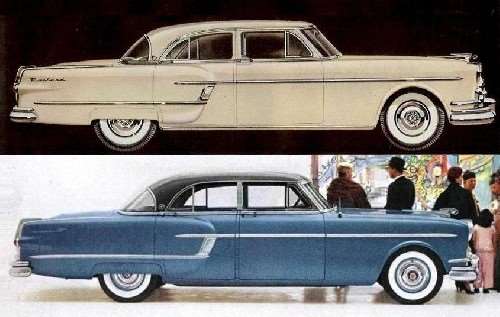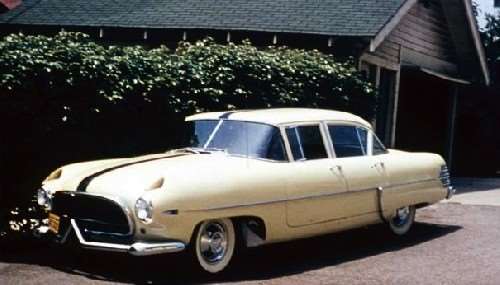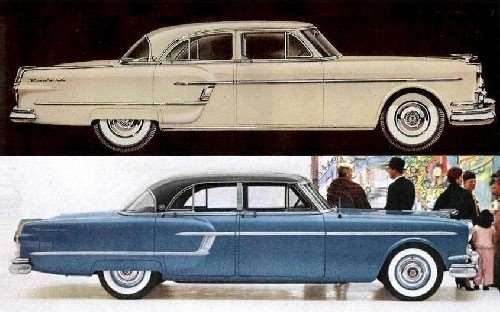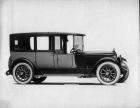|
Re: What would a traditional Packard "Senior" have looked like in 1951?
|
||||
|---|---|---|---|---|
|
Home away from home

|
Very interesting how the ad agency, as you pointed out, did what Packard should have done with the Patrician.
BTW - to my eye, the '54 looks much more elegant with the Senior rear window and fenders than with the Junior rear window and fenders. I understand why you think the smaller glass area on the Junior roof line equates with a more formal look but to my eye it just doesn't work as well as the Senior roof line. Some people like vanilla ice cream and others prefer chocolate! 
Posted on: 2017/8/1 8:46
|
|||
|
||||
|
Re: What would a traditional Packard "Senior" have looked like in 1951?
|
||||
|---|---|---|---|---|
|
Home away from home
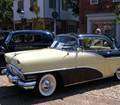
|
I have to disagree with concept of that 1954 Packard advertisement. No wonder James Vance hated Packard advertising! That photo shows some creepy older guy squiring an attractive younger lady with a four-door sedan in the forefront. These were not the people Packard should have been trying to appeal to. By the early 1950s the advertising industry generally tried to appeal to young families or carefree driving in convertibles. Nance was correct when he said that the ad agency handling the Packard account had dropped the ball and that what was appearing in magazines and newspapers was pathetic. By 1954 a Packard was no longer a status symbol. It had lost that appeal to Cadillac following the company's 1948-50 line. Now having decided to swim into its future tied to an anchor named Studebaker, Packard was not particularly well placed to compete in a runaway car market.
Packard had waited far too long to come out with its V-8. Had it brought out a V-8 in 1951 it might have made up for lost ground. Even Studebaker had a V-8 in 1951. I have never received a good answer as to why Packard procrastinated in bringing out something the public clearly wanted.
Posted on: 2017/8/1 10:46
|
|||
|
You can make a lot of really neat things from the parts left over after you rebuild your engine ...
|
||||
|
||||
|
Re: What would a traditional Packard "Senior" have looked like in 1951?
|
||||
|---|---|---|---|---|
|
Home away from home

|
<i>"I have never received a good answer as to why Packard procrastinated in bringing out something the public clearly wanted."</i>
Packard engineers wanted to develop a V-8, but Christopher wouldn't hear of it. Why did he authorize the development of the Ultramatic and not a V-8? I have long had a theory about that - a theory that remains unproven - that because Christopher wanted to make Packard the next Buick, what Buick did, Packard did. Buick stuck with their straight eight - so Packard would stick with its straight eight.Buick developed Dynaflow - so Christopher had the engineers develop Ultramatic. I absolutely agree with you that Packard should have had the V-8 by '51 - or, as the late Robert Neal wrote, absolutely no later than '53. Your comments about the Packard ads are spot-on about the setting. As far as what the agency did to the presentation of the car itself, Mahoning is correct that the agency did what Packard should have done to the production car. I've long thought that if Nance had come to Packard in 1949 when he was first approached, the story would have had a very different ending.
Posted on: 2017/8/1 11:38
|
|||
|
||||
|
Re: What would a traditional Packard "Senior" have looked like in 1951?
|
||||
|---|---|---|---|---|
|
Home away from home

|
(II)
<i>" I have never received a good answer as to why Packard procrastinated in bringing out something the public clearly wanted."</i> Also, John Rinehart had his design - the one that was finally launched in '51 - basically done when the 23rd Series updated bathtubs were launched. Again, Christopher refused to approve it for production. Hugh Ferry approved it after Christopher was fired. Compare the 22nd/23rd Series cars with the '49 Cadillacs. No comparison. Packard's fate was sealed, courtesy of Christopher.
Posted on: 2017/8/1 14:39
|
|||
|
||||
|
Re: What would a traditional Packard "Senior" have looked like in 1951?
|
||||
|---|---|---|---|---|
|
Home away from home

|
That is a very interesting comment about Packard wanting to be the next Buick. Granted, Buicks were and are nice cars, but that seems like setting your sights rather low. As the producer of luxury cars, one would have thought Packard would have kept its eyes on Cadillac, not Buick. I always thought that the Clipper line was supposed to compete with Buick.
James Nance seems to always get the blame for the ultimate demise of Packard, and personally, I think that is unfair. Granted, he did make some poor decisions, such as agreeing to buy Studebaker and opening the Connor plant; but he did not make those decisions in a vacuum. There were quite a number of executives being paid a lot of money to give him information and advice who clearly steered him in the wrong direction. I truly believe that Nance did care about Packard and wanted the company to succeed; but judging by the decisions and actions of George Christopher, I have to wonder whether he really cared or not. I think Packard could have purchased an automatic transmission from either GM or Chrysler that would have worked fine and would have saved the company a lot of money in terms of development and manufacturing. Being the only independent to develop its own automatic did not actually put the company's resources to its best advantages, as compared to bringing out a large, powerful V-8 engine after the war. Car companies had produced V-8 engines since before World War I, so there was nothing unique about them; but by 1950, the V-8 was the feature the public definitely wanted. In 1954, Packard produced 31,291 cars, compared to 444,609 produced by Buick. In 1955 Buick was the third-largest car manufacturer selling 738,814 units! Packard was No. 14 selling a total of 55,247. To use a sports comparison, this is like a high school football team trying to take on Florida State University.
Posted on: 2017/8/1 15:51
|
|||
|
You can make a lot of really neat things from the parts left over after you rebuild your engine ...
|
||||
|
||||
|
Re: What would a traditional Packard "Senior" have looked like in 1951?
|
||||
|---|---|---|---|---|
|
Home away from home

|
<i>"That is a very interesting comment about Packard wanting to be the next Buick."</i>
Christopher had come to Packard from GM, having worked both at Pontiac and Buick. His genius lay in bringing the then most up-to-date production techniques to Packard to launch the 120, a task he performed brilliantly. His downfall - and ultimately Packard's - lay in Christopher's hatred of Packard's luxury cars. Buick in the GM hierarchy of the time was slotted into what we now call the "near luxury" class. Christopher set out to take Packard downmarket. Packard never should have brought out the Six. Yes, they sold a lot of them, but in doing so, they drove their traditional customers to Cadillac. It has often been said, correctly in my view, that Christopher handed Cadillac the luxury car business on a silver platter. Christopher even allowed "business coupes" to be built. Cadillac NEVER went that far downmarket. You could still get a Packard Business Coupe in the 24th Series cars launched in 1951. Christopher was dead set on making Packard the next Buick. It was as if he had an unfathomable personal animosity toward his former employer. This is why I feel he stuck with the straight eight yet had the Ultramatic developed. Buick stuck with their straight eight later than Oldsmobile or Cadillac, but Buick developed Dynaflow whereas Cadillac, Oldsmobile and Pontiac used the Hydra-Matic. You are quite right that Nance is often unfairly blamed for many of the things that went wrong - but what executive other than Nance has ever walked into such a perfect storm of events? Nance was forced into a decision about Conner that was arguably the correct decision ON PAPER. In practice, trying to build complete cars at Conner was a disaster - though by '56 they had the kinks mostly worked out. But by then, the damage had been done. The plan was to extend the assembly line at Conner to alleviate the bottlenecks. They had hoped to be able to do this in conjunction with the launch of the '57s. With the roof crashing in around Packard, this never happened. Conner was never designed to be a complete assembly plant. It was built to be a stamping plant and to assemble "bodies in white." Packard had to move the upholstery shop, the paint shop, everything from East Grand and shoe horn it into Conner. In my view, despite controller Walter Grant's number crunching showing it more cost effective to build complete cars at Conner, they should have continued building "bodies in white" at Conner and continuing with final assembly at East Grand. The move of all assembly operations to Conner sowed the seeds for East Grand becoming the sad symbol of Detroit's decline that we so often see in photographs of Detroit today. The Studebaker fiasco <i>might</i> not have been so bad had George Mason not died and the final merger into American Motors completed. Romney was not interested in Studebaker becoming the low price line in the American Motors lineup. Romney was focused on the Rambler, and it proved to be the right strategy for American Motors so long as Romney was at the helm there. Romney in short order killed off Hudson, the Nash-Healey sports car, the Hudson Italia and the full-size Nashes. In killing off Hudson, he killed off the next generation Hudson, the replacement for the "Step Downs." Hudson's Frank Spring had been behind the development of that car. Spring "retired" from Hudson thanks to Romney and drove the one running prototype of that car from Detroit to his retirement home in California. The friction between Romney and Nance put an end to the component sharing plans Nance and Mason had worked out. There was no way that George Romney was ever going to complete that merger. I'm a fan of Nance, but one of his flaws was that he should have put his ego on the shelf when trying to work with Romney. One reason the merger between the Nash-Hudson half and the Studebaker-Packard half of American Motors never happened was the ego clash between Romney and Nance. Nance didn't have that problem with Mason. A major scandal of the Eisenhower administration that has never gotten the attention it deserves was what ex-GM Chairman Charles Wilson did as Secretary of Defense to insure that Packard wouldn't be able to fund the '57s: the re-writing of Pentagon procurement rules to favor GM and the way he killed Packard and Studebaker's Defense work in the wake of that. The J-47 jet engine contract made the business case for Nance to build Utica. Utica wasn't so much intended as a facility to build V-8s and Ultramatic Drives - that was a fringe benefit. The justification for Utica came in Packard's Defense work and Wilson knew that if he killed Packard's Defense work, he would drive a stake through Nance's plans to restore Packard's luxury car business at Cadillac's expense. Wilson saw to it that GM kept the silver platter on which Christopher had handed GM the luxury car crown. Your figures on Buick and Packard production show the hill Packard had to climb - Sisyphus dragged down by Studebaker! On that 55,000 unit volume, Packard actually made money in 1955 - only to be lost by the hemorrhaging at Studebaker. As further evidence of the challenge Packard faced, search the photos at Hemmings in their Location photo series each day for Packards or Studebakers in the images. Rarely will you find one. Nance faced a daunting task. I believe he gave it his all and that he was an inspiring leader that, had even just one of the events that hit him turned out differently, he and his team would have prevailed and the Packard story would have had a happier ending.
Posted on: 2017/8/1 16:54
|
|||
|
||||
|
Re: What would a traditional Packard "Senior" have looked like in 1951?
|
||||
|---|---|---|---|---|
|
Home away from home

|
Great conversation! 5687, you are changing my thinking on the bulls-nuts taillights and '53-54 grill and trim. And I do love the hardtop's racy backlight. Speaking of which, measuring the body height of blue car vs. artist's, appears the later was sectioned 1.5 inches which is exactly what Reinhart had wanted to do, though I think he also intended the greenhouse to grow taller by same, which would have been a bad move.
Am attaching a final image with 1.5 inches sectioned from blue car because am tired of post-war Packards being looked at as the lunch cafe on first floor of big city hotel while the pre-war classics are the revolving 5-star restaurant at top. Should have never gone down that way and IMHO there is only one person to blame: Ferry. True, Christopher hated the 12th-17th series Seniors. But how could one blame him, they lost money! It was Macauley who ordered the shorty short 110 instead of taking the 120's hood length in the other direction to create a new Senior. Working with what he had, Christopher tried to make decent Seniors out of the Clipper and he's the one who contracted with Henney to build the limo. Yes, he blew it with the bathtubs but his decision to do straight-through body sides was gutsy nonetheless. Of course we all know that in the end he went completely wacko in wanting to rework the Clipper a second time, and was fortunately fired. Nance was a mixed bag just like the rest. I think he was right blow off Mason and later Romney wrt sharing because the only thing Nash had of value to Packard was the '54 integrated A/C, but Mason expected Nance to go along with an Airflyte-based Packard or at least sharing of Nash panels, and insisted that he be Nance's boss. Based on what merits? Just because Mason could envision a Big 4th didn't mean he should have led it. He was as tone deaf as the rest of them when it came to styling and proportions. Nance had a better feel but was still lacking. Case in point: he should have ditched the Contours for 1955 because they were fundamentally deficient by then and still with no provision for a properly proportioned Senior. Instead he should have begged, borrowed and stolen from the bankers and insurance companies to fund something along the lines of the Panther show car - low, wide and with straight-through bodies. Throw in a step-down floor and of course, the V8. People deride the Panther but I think it is a great design that just needed tweaking. Had Nance plotted such a course before close of 1952, by late '53 when Barit approached him with request to buy Hudson he could have had a medium-priced brand of good standing, with a decent dealer network and lots of owners wanting to buy another low-slung Hudson, now Panther-based. I think the V8 is over-blown. You'd think it was as if a car couldn't roll down the road in the early 1950s without it. An yet, Buick did fine without it through 1952, setting one sales record after another. Meanwhile, AMC put Packard's V8 into the big Nash and Hudson and what happened to sales? Absolutely NOTHING. If given the choice between a '51 Contour with a new OHV V8 or the blue Contour work-up below with only a 327 or 356 Eight, I'd bet the farm that the former would have, at best, merely slowed Packard's decline and made it very difficult to fund a Contour replacement, while the latter would have catapulted Packard back near its former glory and easily paid for the 1955 V8 and full redesign two years later.
Posted on: 2017/8/1 19:59
|
|||
|
||||
|
Re: What would a traditional Packard "Senior" have looked like in 1951?
|
||||
|---|---|---|---|---|
|
Home away from home

|
<i>"measuring the body height of blue car vs. artist's, appears the later was sectioned 1.5 inches which is exactly what Reinhart had wanted to do, though I think he also intended the greenhouse to grow taller by same ..."</i>
Yes, Rinehart wanted a lower belt line and taller greenhouse, but engineering and the bean counters dictated the higher belt line because "glass was more expensive than steel." It's sad to know that the bean counter mentality existed even at Packard! <i>"Christopher tried to make decent Seniors out of the Clipper ..."</i> It was Christopher who refused to build more Seniors in the post war sellers market, opting instead to flood the market with the lower-price Juniors. He hated the Senior cars and did all he could to end Packard's dominance of the luxury market. He fully succeeded in that. You are quite right that he went completely wacko in wanting to rework the Clipper a second time. Ferry missed the opportunity to correct what Christopher had done with the launch of the Contours in '51. They deliberately didn't build very many of the Seniors - and for heavens sake, he should have killed off the two door sedan and ESPECIALLY the business coupe! <i>" Mason ... was as tone deaf as the rest of them when it came to styling and proportions."</i> Amen to that! Proof: the post war bath tub Nashes - so ugly they made the Packard bath tubs beauty queens in comparison! And Mason insisted on that low wheel well opening on the front wheels. Nash couldn't get rid of it until Mason died. That low wheel well opening ruined the turning radius of the Nashes. <i>"Nance had a better feel but was still lacking. Case in point: he should have ditched the Contours for 1955 because they were fundamentally deficient by then and still with no provision for a properly proportioned Senior."</i> He wanted to do just that - but there was not enough time from when he arrived in '52 to launch the new body for '55. New car development lead time was four years in those days. Also, Nance found that with the expenditure for Utica and then the shock of losing Briggs as the body supplier and the subsequent scramble for where to build the cars, there was no money to tool for the desired new body for '55. All of that combined with the loss of the Defense contracts dried up the money for the new body. The prewar decision to give Briggs Packard's body building business is another example of how Christopher sowed the seeds of Packard's demise. I remember your Panther work up. It is quite handsome. The front of the Panther as penned by Teague was pretty gruesome, but the sides and rear are quite nice and your workup of it as a sedan came off quite well IMO. The Panther really benefitted from the cathedral taillights when they were retrofitted to a couple of the Panthers. <i>"AMC put Packard's V8 into the big Nash and Hudson and what happened to sales? Absolutely NOTHING.</i> If Packard was going to re-take the luxury crown from Cadillac, it would have to have been done with a V-8 under the hood, as Lincoln and the Imperials were V-8 powered as well as Cadillac. Packard, the "Master Motor Builder", really should have had the V-8 ready for the new body in '51. Even as late as '53, they could have made gains in their market share with a V-8. IMO the Packard V-8 (the 320) in the Nashes and Hudsons didn't sell well in no small measure because Romney was trying to kill off the full-size cars and because he really didn't want to share components with Nance. Romney threw every monkey wrench at his disposal at every aspect of anything that got in his way of making the Rambler THE backbone of American Motors. Nance begged Romney to supply OHV inline sixes for the Studebaker Champions to replace the Studebaker flat head six, but Romney refused. I believe the problem with the sales of the Packard-powered full size Nashes and Hudsons was Romney, not the presence of the Packard V-8 in those cars. On the Hudson side of the equation, traditional Hudson buyers were alienated by the "HASH" much as Packard buyers were alienated in '57-'58 by the Packardbakers.
Posted on: 2017/8/2 1:28
|
|||
|
||||
|
Re: What would a traditional Packard "Senior" have looked like in 1951?
|
||||
|---|---|---|---|---|
|
Home away from home
|
Would just point out that the bathtub Nashes gave Nash the best years of their life, saleswise. They are also very nice to drive, especially the Ambassadors.
There are Nash sales training films on Youtube that make no bones that the V8 Nashes were hard for the salesmen to sell because of the high price. Not to mention that '52 body was pretty hard to disguise, more so than Packard's countour. I am sure they would have also loved to have a new body for 55 but the economics probably were not there. I am at a loss with this fascination with incredible hood length and increased wheel to door measurement. Cars at that size become so unwieldy to drive and park. Increased overhang just means much more inelegant scraping while entering typical driveways. The vast bulk of sales go to people who do not have circle drives. By the way, Caddies at that time had a relatively short hood. I have spent some time driving around in cars with early Hydramatics and I comprehend FULLY why Packard did their own transmission. Whether in a Caddy, a Kaiser or a Nash, they always seem to be in the wrong gear while negotiating the hills and curves in the country and my best efforts with shop manual in hand fails to produce a less than jarring shift quality. Yes, they do take off with a rush, and they seem to be durable, but otherwise I find them annoying as all getout to drive.
Posted on: 2017/8/2 6:04
|
|||
|
||||

 (66.08 KB)
(66.08 KB)